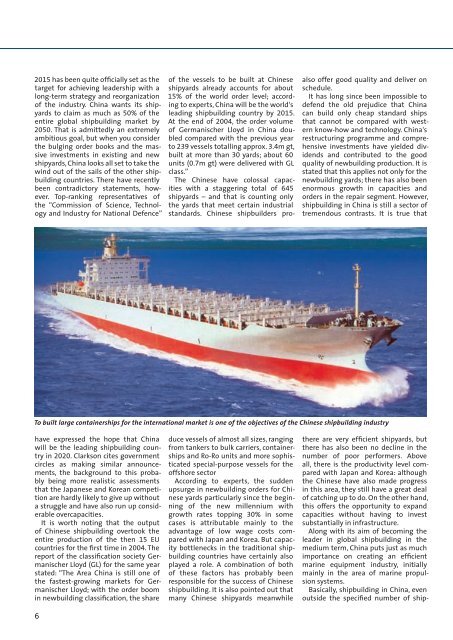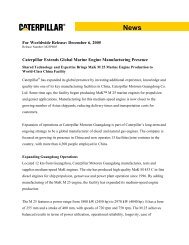Excellence on Board - Marine Engines Caterpillar
Excellence on Board - Marine Engines Caterpillar
Excellence on Board - Marine Engines Caterpillar
Create successful ePaper yourself
Turn your PDF publications into a flip-book with our unique Google optimized e-Paper software.
2015 has been quite officially set as the<br />
target for achieving leadership with a<br />
l<strong>on</strong>g-term strategy and reorganizati<strong>on</strong><br />
of the industry. China wants its shipyards<br />
to claim as much as 50% of the<br />
entire global shipbuilding market by<br />
2050. That is admittedly an extremely<br />
ambitious goal, but when you c<strong>on</strong>sider<br />
the bulging order books and the massive<br />
investments in existing and new<br />
shipyards, China looks all set to take the<br />
wind out of the sails of the other shipbuilding<br />
countries. There have recently<br />
been c<strong>on</strong>tradictory statements, however.<br />
Top-ranking representatives of<br />
the “Commissi<strong>on</strong> of Science, Technology<br />
and Industry for Nati<strong>on</strong>al Defence”<br />
have expressed the hope that China<br />
will be the leading shipbuilding country<br />
in 2020. Clarks<strong>on</strong> cites government<br />
circles as making similar announcements,<br />
the background to this probably<br />
being more realistic assessments<br />
that the Japanese and Korean competiti<strong>on</strong><br />
are hardly likely to give up without<br />
a struggle and have also run up c<strong>on</strong>siderable<br />
overcapacities.<br />
It is worth noting that the output<br />
of Chinese shipbuilding overtook the<br />
entire producti<strong>on</strong> of the then 15 EU<br />
countries for the first time in 2004. The<br />
report of the classificati<strong>on</strong> society Germanischer<br />
Lloyd (GL) for the same year<br />
stated: “The Area China is still <strong>on</strong>e of<br />
the fastest-growing markets for Germanischer<br />
Lloyd; with the order boom<br />
in newbuilding classificati<strong>on</strong>, the share<br />
of the vessels to be built at Chinese<br />
shipyards already accounts for about<br />
15% of the world order level; according<br />
to experts, China will be the world‘s<br />
leading shipbuilding country by 2015.<br />
At the end of 2004, the order volume<br />
of Germanischer Lloyd in China doubled<br />
compared with the previous year<br />
to 239 vessels totalling approx. 3.4m gt,<br />
built at more than 30 yards; about 60<br />
units (0.7m gt) were delivered with GL<br />
class.”<br />
The Chinese have colossal capacities<br />
with a staggering total of 645<br />
shipyards – and that is counting <strong>on</strong>ly<br />
the yards that meet certain industrial<br />
standards. Chinese shipbuilders pro-<br />
duce vessels of almost all sizes, ranging<br />
from tankers to bulk carriers, c<strong>on</strong>tainerships<br />
and Ro-Ro units and more sophisticated<br />
special-purpose vessels for the<br />
offshore sector<br />
According to experts, the sudden<br />
upsurge in newbuilding orders for Chinese<br />
yards particularly since the beginning<br />
of the new millennium with<br />
growth rates topping 30% in some<br />
cases is attributable mainly to the<br />
advantage of low wage costs compared<br />
with Japan and Korea. But capacity<br />
bottlenecks in the traditi<strong>on</strong>al shipbuilding<br />
countries have certainly also<br />
played a role. A combinati<strong>on</strong> of both<br />
of these factors has probably been<br />
resp<strong>on</strong>sible for the success of Chinese<br />
shipbuilding. It is also pointed out that<br />
many Chinese shipyards meanwhile<br />
also offer good quality and deliver <strong>on</strong><br />
schedule.<br />
It has l<strong>on</strong>g since been impossible to<br />
defend the old prejudice that China<br />
can build <strong>on</strong>ly cheap standard ships<br />
that cannot be compared with western<br />
know-how and technology. China‘s<br />
restructuring programme and comprehensive<br />
investments have yielded dividends<br />
and c<strong>on</strong>tributed to the good<br />
quality of newbuilding producti<strong>on</strong>. It is<br />
stated that this applies not <strong>on</strong>ly for the<br />
newbuilding yards; there has also been<br />
enormous growth in capacities and<br />
orders in the repair segment. However,<br />
shipbuilding in China is still a sector of<br />
tremendous c<strong>on</strong>trasts. It is true that<br />
To built large c<strong>on</strong>tainerships for the internati<strong>on</strong>al market is <strong>on</strong>e of the objectives of the Chinese shipbuilding industry<br />
6<br />
there are very efficient shipyards, but<br />
there has also been no decline in the<br />
number of poor performers. Above<br />
all, there is the productivity level compared<br />
with Japan and Korea: although<br />
the Chinese have also made progress<br />
in this area, they still have a great deal<br />
of catching up to do. On the other hand,<br />
this offers the opportunity to expand<br />
capacities without having to invest<br />
substantially in infrastructure.<br />
Al<strong>on</strong>g with its aim of becoming the<br />
leader in global shipbuilding in the<br />
medium term, China puts just as much<br />
importance <strong>on</strong> creating an efficient<br />
marine equipment industry, initially<br />
mainly in the area of marine propulsi<strong>on</strong><br />
systems.<br />
Basically, shipbuilding in China, even<br />
outside the specified number of ship-














